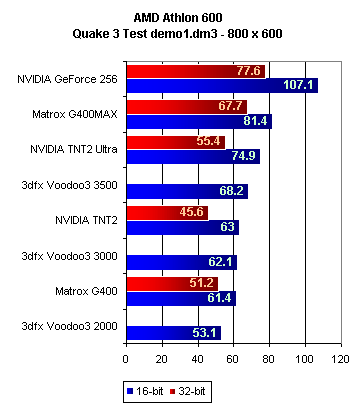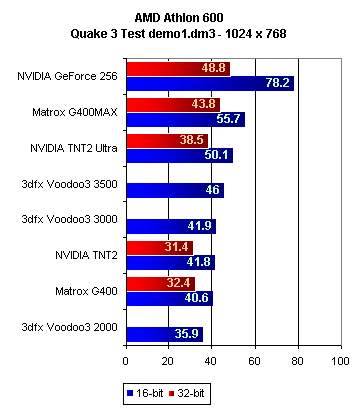AMD Athlon Buyer's Guide - Part 3: Video Cards
by Anand Lal Shimpi on November 11, 1999 10:01 PM EST- Posted in
- Guides

We're back to the starting point again, this time with a "slower" Athlon 600 at the helm. The performance of all the cards is quite respectable but the important thing to look at in the tests as we change processors is how the standings change as the CPU performance decreases. It's difficult to see any changes at 640 x 480 because of the already high scores, so let's take a look at how the 100MHz decrease in CPU speed affects real world gaming performance at higher resolutions.

The G400MAX begins to separate itself from the TNT2 Ultra by a noticeable margin. For one thing the TurboGL driver is being used here and helps performance tremendously (the performance of the final drivers with the full and optimized ICD should be identical) and the second factor that affects the G400MAX's performance advantage over the TNT2 Ultra is the fact that the Athlon 600 is such a fast processor. The G400 itself seems to do much better and truly shine on processors faster than a Pentium III 450, and, of course, an Athlon 600 is considerably faster than a Pentium III 450. The performance difference in 32-bit color is fairly large, but the GeForce 256, even with its slower memory speed (166MHz vs 200MHz) manages to pull ahead of the G400MAX by a good 10 fps.

Once again the 32-bit rendering performance gap between the G400MAX and the GeForce is reduced to around 5 fps when the resolution is increased to 1024 x 768. This is due to the fact that so much memory is being consumed in the jump to 1024 x 768 that the dependence upon a fast memory bus grows as the color depth increases to 32-bits (higher color depths require more memory).










2 Comments
View All Comments
care205 - Monday, May 26, 2014 - link
http://ggggggggggg.us">wwwwwwwwwwww
care205 - Monday, May 26, 2014 - link
<a href="http://ggggggggg.us">wwwwwwwww</a>